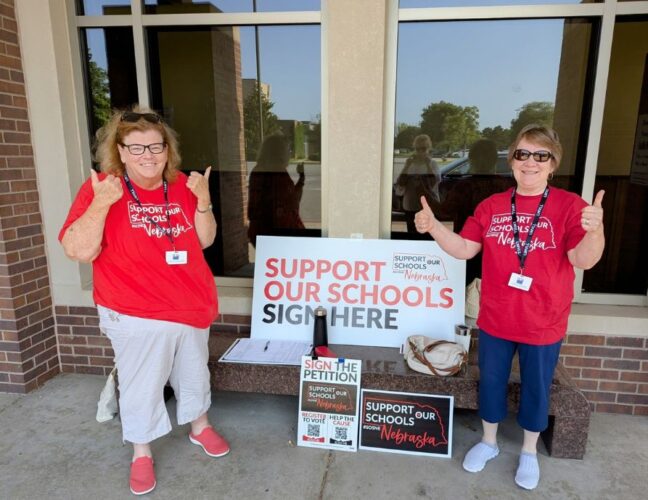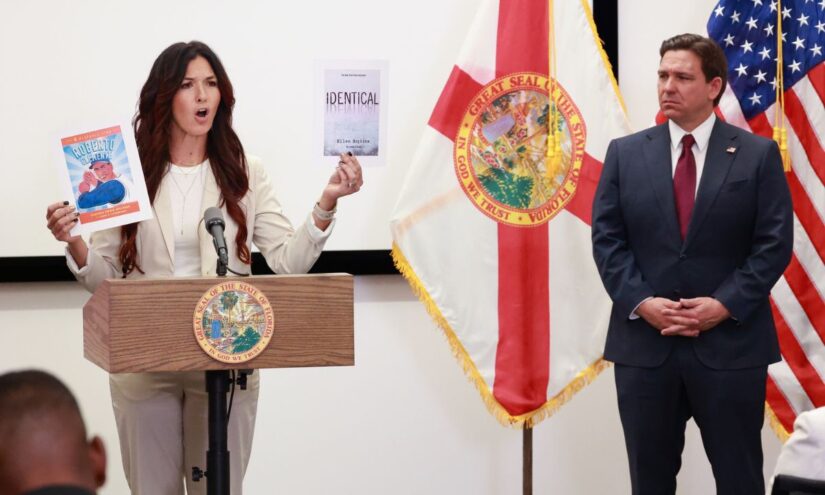School Choice Questions Dominate November Ballot Propositions
Measures in Colorado, Kentucky and Nebraska are among 11 ed-related issues on the ballot. Others address facility upgrades, school board partisanship.

Get stories like these delivered straight to your inbox. Sign up for The 74 Newsletter
This article is part of The 74’s EDlection 2024 coverage, which takes a look at candidates’ education policies and how they might impact the American education system after the 2024 election.
Voters have a history of rejecting private school choice measures at the ballot box. Recent voucher proposals garnered less than a third of the vote. But advocates in three states are hoping to break that trend on Election Day.
In Nebraska, voters will decide whether to preserve or overturn 2023 legislation that created a private school scholarship program. Initiatives in Kentucky and Colorado, if approved, could pave the way for lawmakers to create vouchers or education savings accounts in the future.
Despite past defeats, “school choice is continuing to gain support across the country with every demographic,” said Ben DeGrow, a senior policy director at ExcelinEd, which supports the expansion of private school choice. “We’re only likely to see more states add programs by the end of the decade.”
Over the past two years, several GOP governors and lawmakers have been able to push through education savings accounts, which allow families to use state funds for private school tuition, homeschooling or a combination of programs. Nearly 600,000 students in eight states were enrolled in universal ESA programs in 2023-24, according to FutureEd, a think tank at Georgetown University. In 2022, only Arizona had a universal program that served about 60,000 students. But it’s unclear if that momentum will continue at the polls in the face of opponents who argue such programs hurt public schools.
11 measures in 9 states
The questions on school choice are among 11 education-related initiatives on the ballot in nine states this November. Other measures likely to drive voters to the polls include a union-led Massachusetts proposal to relax high school graduation requirements and a Florida question asking whether school board elections should be officially partisan. A few measures would impact school funding, including a California bond issue that would provide $8.5 billion to modernize outdated K-12 schools.
But with enrollment in district schools continuing to decline, the questions about public funds for private schools have attracted the most attention.
While Colorado offers charter schools, there are few school choice options in Nebraska and Kentucky. Votes in favor of choice in those states would “represent a significant step forward for families in terms of educational opportunity,” DeGrow said.

But all three states have large rural areas, where resistance to vouchers has traditionally been strong. In states like Texas, Republican lawmakers from rural communities have been the fiercest opponents. Some worry ESAs would prompt more families to choose homeschooling and private schools, forcing public schools to close or consolidate. Others argue such programs don’t benefit families in rural areas because there aren’t enough private schools.
The question is “whether rural voters themselves can be convinced to support vouchers,” said Kevin Welner, director of the National Education Policy Center at the University of Colorado Boulder.
Well-funded conservative organizations, like Americans for Prosperity in Colorado and the American Federation for Children in Nebraska, have tried to make the case that voters need to pass school choice to keep up with neighboring states offering more education options for families.
While teachers unions have mobilized against private school choice, “I expect that the money battle will be lopsidedly pro-voucher,” Welner said. “It will be interesting to see how much of an effect that money has in shifting popular opinion.”
In Kentucky, Amendment 2 wouldn’t automatically result in a school voucher program, but asks voters if they want public funds to pay for education outside of what the law calls a “system of common schools.”
Until now, Kentucky courts have had the final say over whether the state joins the 29 others with at least one school choice program. In 2022, the state Supreme Court said a 2021 law creating tax credits for “education opportunity accounts” violated the state constitution. A yes vote on the ballot measure would give the Republican-dominated legislature a “safe, legal path” to pass a school choice program, DeGrow said.
Supporters like Republican Rep. Jared Bauman say it’s time for the state to catch up with neighbors like Indiana and Ohio that offer parents some form of school choice. But opponents of the referendum, including Democratic Gov. Andy Beshear, warn that a voucher plan could cost the state as much as $1.19 billion if it reached a scale similar to that of Florida’s universal program.
The “common schools” wording of the constitution has also held up efforts to fund charters. Kentucky has had a charter school law since 2022, but in December a state court judge ruled it unconstitutional.
In Nebraska, where lawmakers passed a $10 million private school scholarship program last year, Support Our Schools Nebraska, a union-led advocacy group, gathered enough signatures this summer to put a veto referendum on the ballot.
Like public school supporters in other states, opponents argue that such programs are a drain on state budgets and mostly serve families who already pay for private school instead of the neediest students. But Republican state Sen. Lou Ann Linehan, who sponsored the school choice legislation, argues that students shouldn’t have to attend schools that are failing or can’t meet their needs.

Finally, in Colorado, a ballot question asks voters if they support adding language to the state constitution that would guarantee children a right to the full array of school choice options — traditional district schools, charters, private schools, open enrollment and homeschooling.
Some worry the measure could invite more government oversight into homeschooling, while Welner predicted it would prompt legal challenges “because it’s so vague and yet touches on so many issues.”
Bond issues, graduation requirements
Beyond debates over school choice, several other ballot measures affect both education policy and funding. Here is a brief rundown:
Arkansas
Since 2009, the Arkansas Scholarship Lottery has provided over 720,000 college scholarships, totaling $1.2 billion. But students attending vocational and technical schools haven’t been eligible for the awards. The legislature placed a question on the ballot that would change that.
California
Almost 40% of California’s public schools fail to meet basic facility standards, according to a 2020 report from the Public Policy Institute of California. Students often attend schools with unsafe conditions, like gas leaks, faulty electrical systems or structural damage. Proposition 2 asks voters to approve a $10 billion bond issue that would provide $8.5 billion for new construction and renovations at district schools, charters and career and technical centers. Local districts would have to provide matching funds.
After voters rejected a $15 billion bond in 2020, repair projects have piled up, but in addition to renovating schools, districts would also be able to use the funds for teacher housing. Teachers often can’t afford to live in high-priced parts of the state, like Los Angeles, San Diego and the Bay Area, which creates recruitment and retention challenges for districts in those metro areas.
An anti-tax organization, the Howard Jarvis Taxpayers Association argues that the measure doesn’t make sense at a time when the state is losing enrollment and would likely lead to higher property taxes.
But Public Advocates, which focuses on the needs of low-income students, is opposed for a different reason. They say the measure should include a sliding scale that allots poorer districts a greater share of the funds.
Colorado
A proposed 6.5% sales tax on firearms and ammunition would take effect April 1, 2025 and raise roughly $39 million a year. Most of the revenue would fund services for victims of gun violence, but $1 million would go into a school security program for violence prevention in schools as well as staff training and facility upgrades to improve safety. Another $3 million would expand access to youth behavioral health programs.
Rep. Monica Duran, a Democrat who sponsored legislation to get the measure on the ballot, says the tax doesn’t infringe on gun owners’ Second Amendment rights. But gun lobbyists argue that gun and ammunition purchases are already subject to an 11% federal tax.
Florida
School board races have become increasingly partisan, especially since the pandemic, when issues like mask mandates and disputes over curriculum split communities in half. Republican Gov. Ron DeSantis further politicized school board races in 2022 when he endorsed a slate of 30 candidates, 25 of whom won that year in the general election.
Amendment 1, which the legislature placed on the ballot last year, would officially change the Florida constitution to end nonpartisan races and require candidates to state their political party.
Sixty percent of voters would need to approve the measure for it to pass. If they do, the new provision would apply to elections in 2026. Opponents of the idea argue that education issues have grown overly divisive and that partisan races would disenfranchise voters who aren’t registered party members. Proponents say the requirement would increase transparency.

One former Polk County school board member thinks there won’t be enough support for the measure to reach the 60% threshold.
“I think voters here are actually very tired of the school drama,” said Billy Townsend. “While they tend to vote GOP in state offices, [voters] also tend to prefer non-partisan offices locally. I would bet it falls short of 50%.”
Massachusetts
Decisions over academic expectations are generally left up to state and local school boards. But in Massachusetts, voters will decide whether high school students should still have to pass state exams in English, math and science to graduate.
The Massachusetts Teachers Association, the state’s largest teachers union, led the effort to get the referendum on the ballot. The union argues that teachers spend too much class time preparing students for the tests and that the requirement hasn’t achieved the results testing proponents want. Under their alternative, students would have to master state standards to graduate.
Opponents, however, say scrapping the requirement would ultimately hurt students and leave them less prepared for college and careers. They’ve launched a $250,000 ad campaign to convince voters to reject the measure.
New Mexico
New Mexico voters have a strong track record of approving bond issues for capital improvement projects on education facilities. Since 1995, they’ve approved 43 of 48 that have been on the ballot. This year, they’ll vote on a $230 million package that would fund, among other items, furniture, equipment and materials at school libraries, as well as early childhood education centers at both the state school for the blind and the school for the deaf.
Utah
Utah voters will decide on two school funding measures, both placed on the ballot by the legislature. The first asks voters to remove a state constitutional requirement that all revenue from income taxes and intangible property, like capital gains and royalty payments, be spent on education, children and people with disabilities. If the measure passes, the law would only say that the state must provide a “framework” for funding schools.
The state teachers union was initially neutral on the change, but now opposes it. Lawmakers say revenue is up and this change would make budgeting easier.
The second measure asks voters to increase from 4% to 5% the cap on investment earnings the state can transfer from the State School Fund to education. Local school councils of parents and educators decide how to spend the funds for purchases like library books or an extra teaching assistant position. Last year, the state distributed over $100 million from the fund.
Get stories like these delivered straight to your inbox. Sign up for The 74 Newsletter

;)
